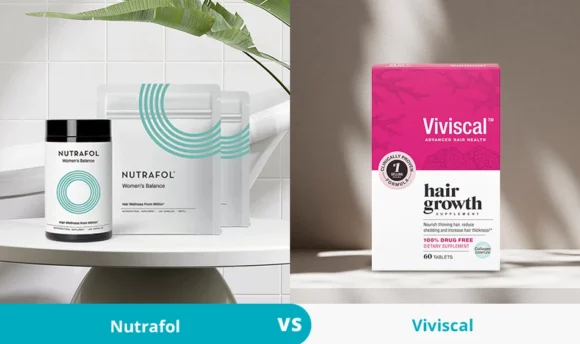How to Get Coconut Oil out of Hair: 11 Strategies That Work
Coconut oil can help repair damaged hair, moisturize, and promote hair growth. But it can also be a challenge to get it out of your hair. Explore 11 of the best techniques to remove coconut oil from your hair.

Coconut oil is a popular hair treatment, praised for its natural ability to strengthen the hair shaft, treat dandruff, and provide a healthy sheen. It’s also a rich source of fatty acids that deeply moisturize and nourish hair.
However, using too much coconut oil or leaving it in the hair for too long can lead to an oil buildup that can cause the hair to appear greasy and weighed down, drawing dirt and pollutants that can lead to more hair issues.
Removing this oil from the hair and the scalp can be challenging, but it’s possible with the right strategies and products.
Explore some of the best methods to get coconut oil from your hair and learn how long to stay with it to keep it healthy and looking its best.
How to Get Coconut Oil Out of Hair
Getting coconut oil buildup out of hair can be a hard task, but there are a few options you can try at home. One is to use clarifying shampoo, which contains ingredients that can remove buildup and residues from the hair, including oils, styling products, and unclog scalp pores. Another option is to use dry shampoo, which helps absorb extra oil without drying your hair.
When dissolved in water, baking soda can help absorb excess oil and remove buildup and other substances from the hair.
Another technique is to rinse coconut oil with a mixture of water and apple cider vinegar. Apple cider vinegar has antimicrobial effects in the form of acetic acid, which may be useful for clearing buildup on the scalp without removing color.
Get Rid of Coconut Oil in Your Hair: 11 Proven Methods
Coconut oil can be difficult to remove from your hair. Explore the 11 proven methods to help you get rid of it. From clarifying shampoos to baking soda and alcohol to help you enjoy healthier-looking tresses.
#1 Use a clarifying shampoo
Clarifying shampoo is designed to eliminate product buildup, oil, and dirt from the hair. This is because of the high concentration of strong surfactants, the ingredients like soap that remove buildup, grease, and pollutants from your hair.
The heavy surfactants are what sets clarifying shampoo apart from traditional shampoo. Regular shampoos contain gentle cleansing agents that emphasize more on moisturizing and enhancing hair shine rather than cleaning it.
Wet your hair and apply a generous amount of shampoo. Massage it into your hair and scalp, then rinse with warm water and apply conditioner.
#2 Use a dry shampoo
Dry shampoo is a great option to remove excess coconut oil from your hair if you don’t have time or don’t want the hassle of washing your hair. Dry shampoo absorbs the extra oil from the hair, leaving it clean and refreshed.
Dry shampoo is made of substances like clay, starch, alcohol, or talc that absorb oil when applied to hair.
Shake the can and hold it about 6 inches from your head. Spray the dry shampoo on your hair, focusing on the oily parts, and massage it with your fingertips. Give it time to soak the extra oil, then brush your hair to distribute it.
Many DIY products can also make great dry shampoo alternatives, including baby powder, cornstarch, setting powder, or a mixture of salt and cornmeal.
Although dry shampoo can save you time, using it too often can be damaging to your hair. It can clog your follicles, reducing the hair’s strength and resulting in hair loss and skin conditions like infections, dermatitis, and acne.
Use dry shampoo no more than 1–2 times per week.
#3 Apply a clay mask
Clay is a natural and efficient ingredient that you can use to remove coconut oil from hair. Because of its negative charge, it attracts toxins and product buildup that are positively charged, resulting in properly cleaned hair.
Clay masks have antibacterial properties that eliminate bacteria, viruses, and fungi on the scalp and hair. This can reduce the symptoms of dermatitis. Additionally, it unclogs pores and gently exfoliates the scalp, reducing dandruff and addressing hair loss or shedding issues.
Mix a tablespoon of clay powder with water to form a thick paste. Apply to your hair, focusing on the oily areas, and massage it with your fingertips. Let it sit for 30 minutes to absorb the excess oil, then rinse it with warm water.
#4 Mix mint, rosemary, and lemon water
Lemon juice naturally contains citric acid and has potent cleansing effects, which, when mixed with rosemary and mint, effectively removes excess hair oil.
Mint and rosemary improve circulation, stimulating hair to grow faster.
Rosemary also contains ursolic acid, an anti-inflammatory and antioxidant that can soothe an inflamed scalp while supplying the hair follicles with more oxygen and nutrients.
Squeeze lemon juice into a cup and stir in a tablespoon each of dried rosemary and mint to make the mix. Bring the mixture to a boil for up to 10 minutes before cooling. Wash your hair and scalp with the mixture and follow up with a moisturizing conditioner or deep conditioning treatment to restore any lost moisture to your hair.
#5 Use a scalp scrub
Scalp exfoliation can effectively remove excess coconut oil from hair while promoting a healthy scalp and hair. Scalp scrubs contain exfoliating ingredients like charcoal, which target excess oil and remove buildup and dead skin cells from the scalp, leaving it clean and refreshed.
Wet your hair and apply a small amount of the scrub to your scalp. Massage the scrub into your scalp and hair. Be gentle with the scrubbing, as too much pressure can damage the scalp and hair. Rinse it out with warm water. Follow up with a moisturizing conditioner.
#6 Crack some eggs
Eggs have lecithin, a naturally occurring substance that helps dissolve oil and grime in your hair. They also include proteins and amino acids, which can cleanse any accumulation while nourishing and strengthening the hair.
Whisk two eggs in a bowl, and apply evenly on your scalp and hair. Let it sit for about 20 minutes, and rinse with warm water. You can follow up with a shampoo to remove any remaining residue from your hair. Finish with a conditioner.
Before applying the mixture, you can add some essential oil if the smell of raw eggs is problematic.
#7 Apply baking soda
While there’s not enough research to support the benefits of baking soda paste on hair, people have reported that dissolving baking soda in water can help eliminate any buildup of oils, and other substances in the hair, leaving it shiny and soft.
You can also use baking soda as a scalp exfoliator due to its powdered form, which may help care for a dry scalp.
Make a thick paste by combining one to two tablespoons of baking soda with water. Massage the paste into your hair and scalp for five to ten minutes. Rinse your hair with warm water, and all the coconut oil will wash out. Follow up with a conditioner.
Since baking soda has a high PH, rinse your hair with apple cider vinegar after using baking soda to balance the scalp’s pH.
The antibacterial properties of ACV also make it excellent against the fungus and bacteria that cause scalp infections and can help restore hair gloss and reduce dryness, making your hair less frizzy.
#8 Rub some alcohol
Alcohol can be another home remedy to help remove coconut oil from your hair. Many shampoos and conditioners have included beer as one of their ingredients, claiming that malt and hops, proteins in beer, may nourish and fortify hair follicles. However, there is no scientific evidence to support this.
Alcohol contains traces of minerals such as calcium and iron, which are important in improving general hair health. Calcium helps absorb iron, an essential mineral and nutrient for sustaining healthy hair growth.
Mix equal parts of vodka and water. Apply the mixture onto your hair, massage it into your scalp and hair, and let it sit for 15–20 minutes. Rinse with warm water and use a moisturizing conditioner since alcohol can dehydrate your hair.
#9 Grab some dish soap
Dish soap has powerful detergents like sodium laureth sulfate and denatured alcohol designed to clean utensils and eliminate grease faster. In the same way, it can wash the oil and grime out of your hair.
Lather a small amount of dish soap on wet hair, and massage it into your scalp and hair like normal shampoo. Rinse your hair with warm water and follow up with a moisturizing conditioner or a deep conditioning treatment since dish soap can dry the hair and scalp.
#10 Add aloe vera
Aloe vera gel works well to remove the extra coconut oil and buildup. It contains antibacterial agents that are gentle enough to remove oils without damaging your hair follicles. Aloe can also help you achieve healthier, softer, and shinier hair.
Mix a teaspoon of aloe vera gel with your regular amount of hair shampoo, suitable for a single wash. Apply the mixture to your scalp and hair, and massage it in until it lathers. Let it sit for 10–15 minutes, and rinse it out.
#11 Absorb with paper towels
If you have oily skin, you undoubtedly carry blotting papers and paper towels in your bag. By gently blotting the areas of your hair with excess coconut oil with a paper towel, you can remove some surface-level oil from your hair. Although you might not get perfect results, you can quickly remove oil from the trouble spots.
How Long Should You Leave Coconut Oil in Your Hair?
Coconut oil can sit on your hair for at least 30 minutes, but you may leave it overnight for the best benefits. Washing it off too soon may prevent the hair and scalp from absorbing its benefits, and leaving it on for too long can draw dirt, lead to buildup, and hair loss.
You can apply coconut oil on your hair as a hot oil treatment or hair mask or add a few drops to your conditioner. You’ll need to section your hair into several sections, warm the oil, and apply it to one section at a time, starting from the roots and working your way down to the tips.
Use your fingers or a wide-toothed comb to distribute the oil evenly throughout your hair.
Massage your scalp to stimulate blood flow and promote hair growth, then cover your head with a shower cap and leave it on for at least 30 minutes or overnight for deeper conditioning.
After the desired time, wash coconut oil from your hair using any of the methods mentioned above.
Why You Should Remove Coconut Oil From Your Hair
If you don’t remove coconut oil from your hair, it can attract dirt and dust, causing a smell on your scalp and hair and leaving it lifeless and dull. Washing your hair will help you achieve lustrous, soft, and healthy hair.
When coconut oil is used regularly without removing it, it can cause too much protein buildup in your hair strands, restricting moisture from reaching dry hair. Your manes may become hard, brittle, and dry, causing split ends and hair breakage.
Additionally, coconut oil is a heavy oil that, when used in excess, can weigh down your hair, making it look oily or greasy. It can also block scalp pores, causing irritation or other scalp issues.
Some people are also allergic to coconuts and everything made from them, including coconut oil. Because of this, we advise staying with it for a short time or doing spot testing of any coconut oil product before using it.
FAQs
Leaving coconut oil on your hair daily can lead to oily hair and scalp, making it look greasy and lifeless, particularly if you have fine hair.
It can take 1–3 washes to wash coconut oil out of your hair, depending on several factors, such as the method you’re using to remove the oil, the amount of oil applied, and the thickness and length of your hair.
If coconut oil stays in your hair for too long, it can clog the pores and cause hair growth to slow down. It can also make your hair greasy and lifeless.
A Word From a Trichologist
Coconut oil has many benefits for hair. It can help minimize frizz, regenerate dull and damaged hair, treat dandruff, and promote regrowth.
Mix coconut oil with a few drops of essential oils, such as lavender or peppermint, for additional aromatherapy benefits. You can also mix it with other carrier oils to help with overall scalp and hair health.
Remember that using too much coconut oil may weigh down your hair. Start with only a teaspoon of oil and gently work it through your hair from the middle to the ends. Use a bit more if you have thick hair.
Conclusion
Coconut oil can help maintain the overall health of your scalp and hair, but it can be difficult and time-consuming to remove it from your hair. This is especially true if you don’t use the proper techniques.
However, using the right strategies and processes, you may quickly and successfully get rid of coconut oil from your hair and enjoy the benefits of beautiful, healthy hair.
Whether you’re using a clarifying shampoo, dry shampoo, scalp scrub, or any other method to wash coconut oil out of hair, remember to use a deep conditioner afterward to replenish any moisture lost.

















































 Select your language:
Select your language: 








